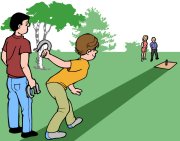
Worksheets and No Prep Teaching Resources
Reading Comprehension Worksheets
Sports

Sports
 Worksheets and No Prep Teaching Resources Reading Comprehension Worksheets Sports |
 Sports |
| edHelper's suggested reading level: | grades 4 to 6 | |
| Flesch-Kincaid grade level: | 5.47 |
|
Close Only Counts in Horseshoes
By Jane Runyon |

|
 1 Since at least two hundred years before Christianity began, men have been nailing iron plates or rings onto the bottoms of horses' hooves. These pieces of metal helped to protect the horse's hooves from damage. The horses were used for moving people and goods from one place to another. If the hoof of one of a man's horses was damaged, that horse could not be used for work. This could cause the owner to lose business or a means of transportation.
1 Since at least two hundred years before Christianity began, men have been nailing iron plates or rings onto the bottoms of horses' hooves. These pieces of metal helped to protect the horse's hooves from damage. The horses were used for moving people and goods from one place to another. If the hoof of one of a man's horses was damaged, that horse could not be used for work. This could cause the owner to lose business or a means of transportation. |
Create Weekly Reading Books
Prepare for an entire week at once! |
| Leave your feedback on Close Only Counts in Horseshoes (use this link if you found an error in the story) |
 |
Sports
|